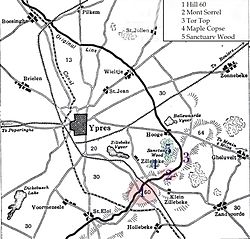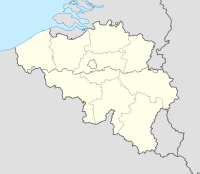| The Bluff | |||||||||
|---|---|---|---|---|---|---|---|---|---|
| Part of the First World War | |||||||||
 The Bluff, St Eloi | |||||||||
| |||||||||
| Belligerents | |||||||||
|
|
| ||||||||
| Commanders and leaders | |||||||||
| Erich von Falkenhayn | Douglas Haig | ||||||||
| Strength | |||||||||
| 2 regiments | 2 brigades | ||||||||
| Casualties and losses | |||||||||
|
14–18 February: 329 2 March: 908 |
14–17 February: 1,294 2–4 March:1,622 | ||||||||
The Actions of the Bluff were local operations in 1916 carried out in Flanders during the First World War by the German 4th Army and the British Second Army. The Bluff is a mound near St Eloi, south-east of Ypres in Belgium, created from a spoil heap made during the digging of the Ypres–Comines Canal before the war. From 14 to 15 February and on 2 March 1916, the Germans and the British fought for control of the Bluff, the Germans capturing the mound and defeating counter-attacks only for the British to recapture it and a stretch of the German front line, after pausing to prepare a set-piece attack.
The fighting at the Bluff was one of nine sudden attacks for local gains made by the Germans or the British between the appointment of Sir Douglas Haig as commander in chief of the British Expeditionary Force (BEF), and the beginning of the Battle of the Somme. The BEF was at a tactical disadvantage, on low boggy ground, easily observed from German positions. A retirement to more defensible ground was impossible but rather than conserving manpower and resources with a tacit truce, the British kept an active front and five of the German local attacks in the period were retaliation for three British set-piece attacks.
The Germans had better weapons and with a homogenous army, could transfer troops and equipment along the Western Front easier than the Franco–British. The German army still had many pre-war trained officers NCOs and soldiers; the British wartime volunteers gained experience in minor tactics but success usually came from firepower; in the underground war, the BEF tunnellers overtook the Germans in technological ability and ambition. Capturing a portion of the opposing front line proved possible but holding it depended on the opponent. When the Bluff was captured, the British retook it; at the Battle of Mont Sorrel Mt Sorrel and Tor Top were retaken by the Canadians and British gains at St Eloi and Vimy Ridge were lost to German attacks. Had the British occupied the front less densely, more training could have taken place and the wisdom of each policy was debated at the time and since.

